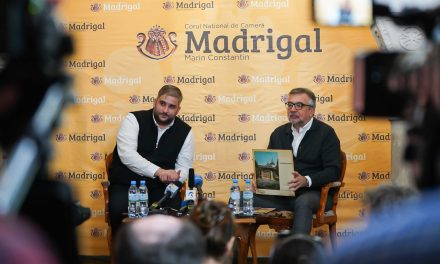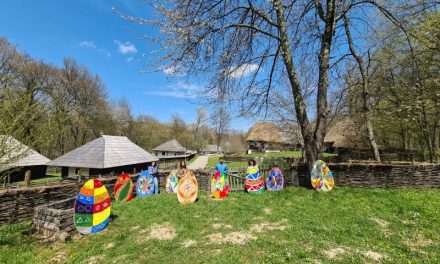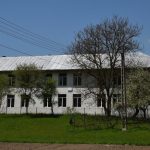On 9 and 10 April 2024, impressive military and religious ceremonies took place in the communes of Soultzmatt and Haguenau, France, commemorating 100 years since the inauguration, by King Ferdinand and Queen Maria of Romania, of the Romanian military cemeteries in Alsace. The events were attended by HRH Prince Radu of Romania, Archbishop Joseph, Metropolitan for Western Europe of the Romanian Orthodox Church, Romanian “Invictus” veterans who participated in international missions in Iraq and Afghanistan, ambassadors, diplomats, civilian, religious and military authorities. The honor guard was provided by the Romanian “Michael the Brave 30th Guards Brigade” and the French “Régiment de Marche du Chad”.
The Great War (WWI) was a global one which included Europe, USA, and countries from Asia, Pacific, Middle East and Africa. About 17 million soldiers and civilians were killed between 1914 and 1918. On the East front in Europe, 800,000 Romanian soldiers fought on the Entente side and 335,706 of them made the ultimate sacrifice. 130,000 Romanian civilians also lost their lives. Modern Romania was built on their bones. The dimension of the Great War tragedy was so touching described by the Canadian author and soldier John McCrae in a famous poem: “In Flanders fields the poppies blow / between the crosses, row by row. / We are the Dead. Short days ago, / We lived, felt down, saw sunset glow, / Loved and were loved, and now we lie in Flanders fields”. A glimpse to those times is a necessary sign of gratitude for the memory of the fallen.
In the spring of 1916, Romania was insistently requested by France and Great Britain to enter the war in order to relieve the huge German pressure on the West front. Queen Maria of Romania, who was British by birth and a granddaughter of Queen Victoria, strongly advocated entering the war on the Entente side. The Allies promised to launch an offensive in Greece and to assist Romania against an attack coming from the South of the Danube River. Despite a strategically vulnerable position, Romania intervened in WW I and in August 1916 crossed the Carpathian Mountains into Transylvania, where its soldiers were received as liberators because the province was ethnically and historically Romanian.
As Romanian troops advanced rapidly in Transylvania, Kaiser Wilhelm II of Germany told his aides: “The war is lost” and field marshal Von Hindenburg wrote: “Judging by the military situation, it was to be expected that Romania had only to advance where she wished to decide the world war.”
But there was no Allied offensive in Greece and no military support on the Danube. The German High Command put on hold all other campaigns, throwing its main weight against Romania, which was simultaneously attacked from three sides. The Romanian Government was forced to withdraw from Bucharest to Iasi, in Moldova. To protect the retreat, a fierce resistance was organized on the peaks of the Carpathians, closed to my native town Campulung Muscel. To make the defense impenetrable, the Romanian High Command brought there the 70th Infantry Regiment formed by inhabitants of the region, who had their families living in villages just behind the frontline. They successfully stopped the advance of much better equipped and trained German Alpine Corps (one of the German commanding officers was the future marshal Erwin Rommel). It was a “Romanian Thermopylae”. A reminder of that terrible battle are the relics of over 2,300 soldiers who rest for eternity in 21 crypts of the impressive Mausoleum on the Mateiaș Mountain. Those who fell prisoners during the retreat were transferred to German prison camps. Thus begins the story of the 2344 Romanian soldiers who died in captivity in Alsace, most of them during the harsh winter of 1917, due to ill-treatment, malnutrition, frost and exhaustion (data engraved on the crosses attests that the number of deaths was 25-30 per day).
In the USA, during the American Civil War, President Abraham Lincoln declared that everyone who died defending the Union must have an individual grave, and on 17 July 1862 established national legislation instituting the system of national cemeteries. Based on this model, at the end of WWI former belligerent states agreed to provide individual and permanent graves, so each soldier who died for his country be genuinely acknowledged as an individual, and his name be preserved forever.
On 30 August 1919, the French village of Soultzmatt donated to Romania, in Val du Pâtre (Shepherd’s Valley), the land needed to bring together the remains of Romanian soldiers dispersed around 35 Alsatian towns and villages. Soultzmatt military cemetery is the largest Romanian necropolis in France, containing the graves of 678 soldiers: 553 individual tombs, and two common graves with the remains of 125 prisoners who died of frost on the night of 27 January 1917. 27 Alsatian families risked their lives to provide food and clothes to Romanian prisoners; all their names were mentioned during the remembrance ceremony on 9 April 2024.
The Soultzmatt cemetery was unveiled on 9 April 1924 by King Ferdinand and Queen Maria of Romania. General Henri Berthelot, military governor of Strasbourg, who during the war led the French military mission in Romania, also attended that ceremony. The Queen placed flowers on each grave and, on the monumental central cross, a marble plaque bears her words: “Romanian soldiers! Far from your homeland for which you sacrificed yourselves, rest in peace, haloed with glory in this land which is not foreign to you”. The next day, the Royal couple attended a similar ceremony at the military cemetery in Strasbourg, where Romanian soldiers were also buried. Between 1969 and 1972, their remains and of those resting in Colmar (in total 472 bodies) were transferred to the Romanian military square “St. George” in Haguenau.
A hundred years on, France and Romania remember together a slice of their common history: the link between the Romanian soldiers who rest in French soil and the compassionate local community which respected the prisoners in both life and death. In September 2023, the Romanian necropolis in Soultzmatt has been included on the UNESCO World Heritage List.
Back in time on the Eastern front, in July 1917, under the command of general (future marshal) Alexandru Averescu, the Romanian Army succeeded in breaking the Austro-Hungarian front in the Battle of Mărăști. German general Von Mackensen promptly launched a counterattack at Mărășești, announcing his superiors “Gentlemen, see you in two weeks in Iasi!”, while the Austro-Hungarian army attacked the Oituz Valley. But both offensives were repelled with heavy losses by Romanians, who in some occasions fought only with the bayonets. The Battle of Marasesti, where almost 22,000 Romanian soldiers lost their lives, is considered “The Romanian Verdun”. In 1918, Romania ended the Great War on the side of the victorious.
When the official ceremonies in Soultzmatt were over, a teenager approached us and introduced himself as “Yann Hoffer, a Franco-Romanian citizen”. Born in Romania and raised in France, he wanted to read his thoughts written for that occasion:
“With boundless emotion, I share a story with you on this day of commemoration. A story impossible to tell. A story forgotten forever. It’s George’s story. George. A common name. An ordinary human being, with a tragic destiny. George was a shepherd. He marveled at the simple things in life: the song of the birds, the soothing presence of the Danube. George never thought that one day he would have to leave his native land. And yet, here and not on the banks of the Danube, was the place where his heart stopped beating on a winter evening. His eyes were focused on the snowflakes that covered the barbed wire with an elegant white coat. Then came the darkness. George that I described to you probably never existed. Maybe his name was John, or Basil. We will never know. If I tried to imagine a portrait of one of the 678 heroes we commemorate today, it is because their stories, all different, are similar. Stories of lives unjustly destroyed by the human madness called “war”. Our duty is not to forget them. History is made of stories and, as Henri Lacordaire reminded us in the 19th century, “history is the memory of the world”. In these uncertain times, when wars rage again, European cohesion is more crucial than ever. As far as I am concerned, as a citizen of tomorrow, I trust this Europe rich in in lessons learned from a sometimes-tragic past. I trust in the future, I trust that George will not have died in vain. Long live the peace!” 
Dr. Ion I. Jinga
Note: The opinions expressed in this article no not bind the official position of the author.








